#insular dwarfism
Text
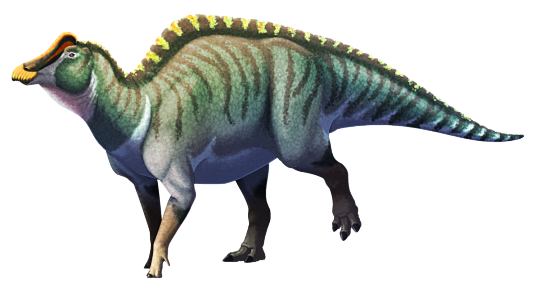
For a long time there were no hadrosaurid fossils known from Africa.
This seemed to mainly be due to the limits of the geography of their time. Hadrosaurs evolved and flourished during the late Cretaceous, when Africa was isolated from all the other continents, and they didn't seem to have ever found their way across the oceanic barriers.
…Until in 2021 a small hadrosaur was discovered in Morocco, a close relative of several European species, showing that some of these dinosaurs did reach northwest Africa just before the end of the Cretaceous - and with no land bridges or nearby island chains to hop along, they must have arrived from Europe via swimming, floating, or rafting directly across several hundred kilometers of deep water.
And now another hadrosaur has just been described from the same time and place.
Minqaria bata lived in Morocco at the very end of the Cretaceous, about 67 million years ago. Only known from a partial skull, its full appearance and body size is unknown, but it probably measured around 3.5m long (~11'6") – slightly larger than its previously discovered relative, but still very small for a hadrosaur. It might represent a case of insular dwarfism, since at the time Morocco may have been an island isolated from the rest of northwest Africa.
Along with its close relative Ajnabia, and at least one other currently-unnamed larger hadrosaur species, Minqaria seems to be part of a rapid diversification of hadrosaurs following their arrival in Morocco, adapting into new ecological niches in their new habitat where the only other herbivorous dinosaur competition was titanosaurian sauropods, and the only large predators were abelisaurs.
If the K-Pg mass extinction hadn't happened just a million years later, who knows what sort of weird African hadrosaurs we could have ended up with?
———
NixIllustration.com | Tumblr | Patreon
#science illustration#paleontology#paleoart#palaeoblr#minqaria#hadrosaur#hadrosauridae#ornithopod#ornithischia#dinosaur#art#insular dwarfism#african hadrosaurs!
436 notes
·
View notes
Text

Paleovember 2023, Palaeoloxodon falconeri!
If you recall back to last year, you'll remember that one piece I drew of Palaeoloxodon namadicus, which not only was possibly the biggest elephant to ever exist, but possibly the biggest LAND MAMMAL to ever exist. Well, it turns out that, while elephants and their relatives are famous for being the biggest things in their environment, they also produced some suprisingly small species, predominantly thanks to a phenomenon called 'insular dwarfism', where normally large animals are instead very small as an adaptation to live on islands. Here we have Palaeoloxodon falconeri, a VERY small species of dwarf elephant that lived on the islands of Malta and Sicily until 400 thousand years ago. Standing only 3 feet tall at the shoulder, these miniature elephants lived alongside other island-based oddities, like a similarly miniature hippo species and a giant swan. Surprisingly, Palaeoloxodon falconeri were fairly long-lived and had steady growth rates for their size, taking longer to reach maturity than other elephants.
#Palaeoloxodon falconeri#elephant#insular dwarfism#pleistocene#sicily#malta#prehistoric#evolution#illustration#characterdesign#art#artwork#cartoon#procreate#art challenge#paleontology#paleoart#artist on tumblr
30 notes
·
View notes
Text
one cool fact i learned today: a handful of mammoths managed to survive on a small forlorn island off the coast of greenland up until the time when the first pyramids were being built
#the story of how they managed to survive mainland extinction as a consequence of habitat loss and extensive hunting is also very interesting#eventually they were brought down by mutational meltdown as their population was far too small and lacking in genome diversity#and they also displayed insular dwarfism as a consequence of their prolonged isolation from the mainland cousins that went long extinct#aaah so sad but so interesting#i love the evolutionary genetics/biology documentaries on the pbs youtube channel#i can't believe they're free and available for everyone's benefit#rant.txt
1 note
·
View note
Note
Ok so i've looked into the show, and there's a combiner named Tritan. Why am I imagining that he's so short in comparison to cybertronians? honest thought really
That might be because the (Cybertronian!Tritan and tobot tritan is his childbaby) au that has been mentioned
I'm pretty sure that the firetruck tobot R is taller than Heatwave so
#plus Cybertronians seem to vary in height quite a lot more than the tobots seem to#though you can argue that they merely look taller because most of the humans they regularly deal with are smaller#heatwave is an unusually small firetruck and i think that's because of Griffin rock and insular dwarfism#since island is small then big things become small#tobots#transformers
1 note
·
View note
Text
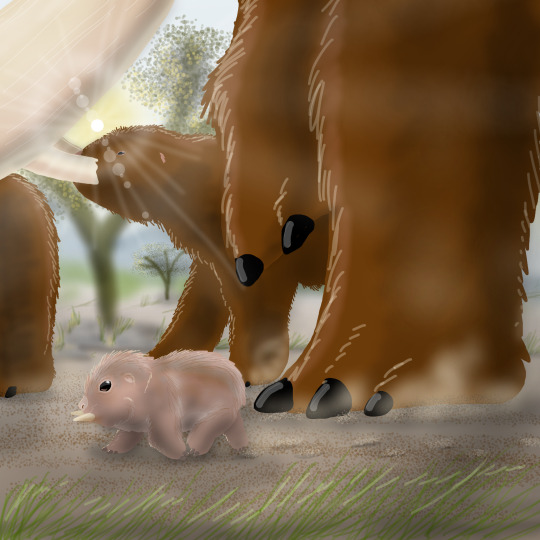
'Startled by the rumbling of enormous approaching footsteps, a foraging straight-tusked marmoth (Nanomammuthomys pliodens), a diminutive creature barely four or five kilograms in weight, flees to the safety of its burrow, scurrying past and beneath the stomping feet of towering beasts resembling itself but hundreds of times bigger: a herd of three-meter tall, six-ton maustodons. Despite their tremendous disparity in size, only about twenty or so million years separates the two species: the polar extremes of a sudden, dual trend of insular dwarfism and insular gigantism on the subcontinent of North Westerna. The last of the hammoths, small stunted remnants of their Glaciocene kin, persisted on the landmass, and grew even smaller to exploit new niches, but to combat larger predation that came much later, their greater cousins once more returned to the sizes of their bygone relatives. In between them, hammoths of various shapes and sizes coexist, from sheep-sized mountain grazers to buffalo-sized plains herders, but it is between this two species in particular that the dramatic newfound diversity of a clade almost condemned to oblivion becomes ever so strikingly evident.'
------------
#speculative evolution#speculative biology#spec evo#speculative zoology#hamster's paradise#art one shot
83 notes
·
View notes
Text
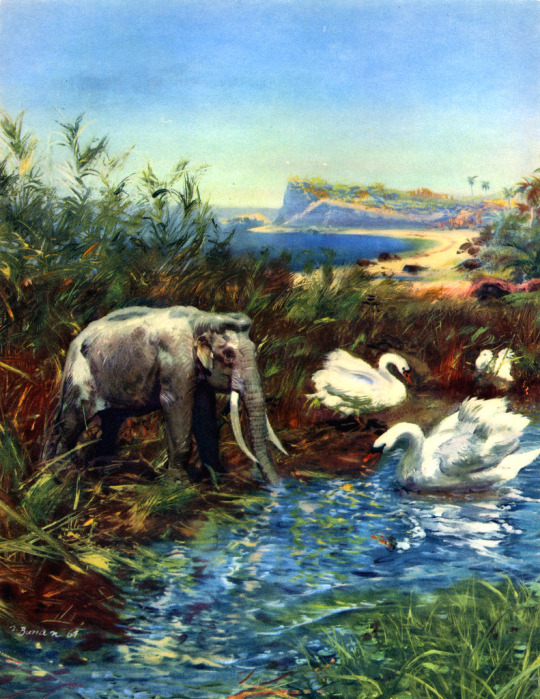
Palaeoloxodon falconeri, Falconer’s dwarf elephant, by Zdeněk Burian
… whoops. Honey, I shrunk the elephants.
Remember when I said Palaeoloxodon was huge, bigger than a mammoth? Turns out it also occupies the other extreme of the elephant size continuum. Palaeoloxodon falconeri from Malta and Sicily is an example of insular dwarfism, where big animals evolve to be smaller on islands. In this case a fully grown adult P. falconeri was the size of a modern elephant calf.
Burian not only gives us some nice island scenery, but also helpfully adds some swans for scale. The result is surprisingly endearing and even cute.
91 notes
·
View notes
Text

†Homo floresiensis
Art credit: Julio Lacerda
This hominin species was endemic to the Indonesian island of Flores from 100,000 to 60,000 years ago. Because of a phenomenon known as insular dwarfism, where island animals grow smaller due to less available food, H. floresiensis grew to a height of only 3 ft 6 in (1.06m) tall, giving it the species nickname of hobbit. They likely had a similar generalist diet to us, and are known to have crafted stone tools to help them hunt. They lived alongside other prehistoric inhabitants of Flores, including cattle-sized relatives of elephants, rabbit-sized rats, human-sized storks, and Komodo dragon lizards.
#markhors-menagerie#primates#apes#great apes#hominins#animal facts#fun facts#palaeontology#prehistoric life#prehistoric animals#homo floresiensis
98 notes
·
View notes
Text
Dungeon Meshi Evolutionary tree!
Quick note at the beginning: this is just me speculating, mostly based on how the diffrent species look as well as the bit of other info we get in the manga. I can‘t DNA-test them.
Evolutinary tree Number one:
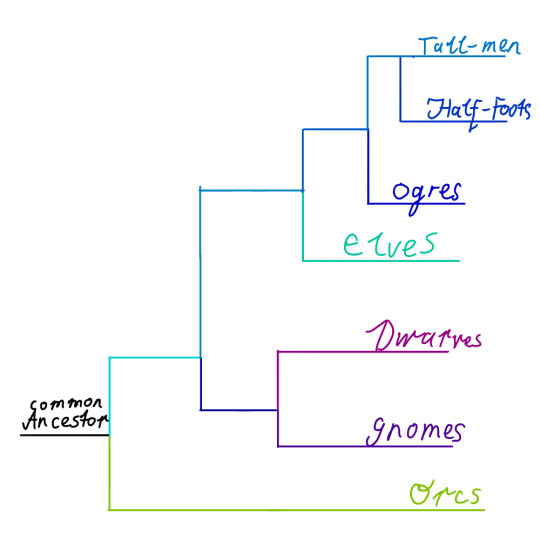
Evolutionary Tree Number Two:
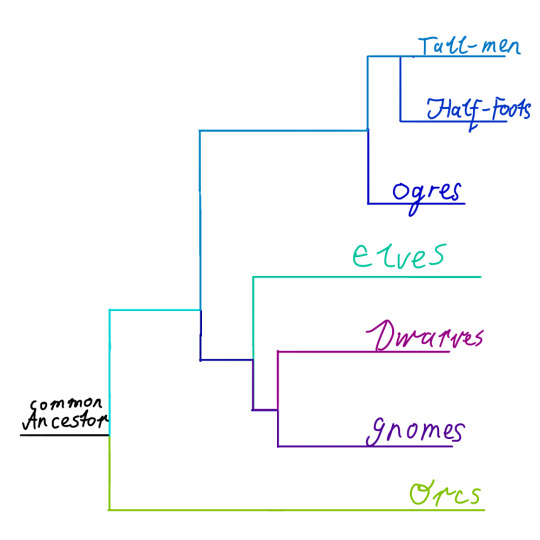
I think Orcs are the species who branched off first and is thus the most distantly related to everyone else. This is mostly based on the fact that they still have fur and very large canines, both traits that got lost very early on in human evolution, leading me to assume that they split off before those traits got lost in other humanoids. Orcs also have a noticably diffrent nose from all the others, so I assume that developed only after they split off. Them splitting off early would have allowed for more time for that to happen, as it only happend in their branch.
Now comes the point I‘m the least certain about: Did Dwarves and Gnomes split off, leaving Elves closer related to Tall-men, Ogres and Half-Foots (Evolutionary Tree Number 1), or did Dwarves, Gnomes and Elves split off together, meaning Elves are closer related to Dwarves and Gnomes (Evolutionary Tree Number 2)?
Number one is pretty much just based on looks, as Elves look very similar to Tall-men, Ogres and Half-foots, suggesting that they may be quite closely related, while Dwarves and Gnomes look a bit more „weird“. In this case Elves still split of earlier from Tall-men than Ogres did, as they are more diffrent from Tall-men.
Number two is based on the fact that Elves, Gnomes and Dwarves are all long-lived species and it would make sense for them to be closer related to each other.
I do assume in both cases that Gnomes and Dwarves are closer related to each other than to anyone else, beeing both short, long-lived races and sharing some other traits, most notably their big ears and big noses, giving them somewhat similar facial traits.
Now onto the last three Species: Ogres/Oni, Tall-Men and Half-Foots. My assumption is that Orge and Tall-Men are in kind of a Neanderthal-Homo Sapiens-Situation, with Ogres originating from a colder climate, which leads to them beeing overall bigger to better deal with the colder temperatures. (It is called Bergmann‘s rule, it has to due with the square-cube-law. Short version, bigger bodies have proportionally less surface area and thus loose less heat)
My theory for Half-Foots is that they are a offshoot of tall-men that shrunk due to insular dwarfism, as they look very similar to Tall-men except for their size, thus often beeing mistaken for Tall-Men children, and it doesn‘t seem like Half-Foots are very widespread. (Insular dwarfism also happend with Homo Floresiensis, a noticablly very small species of irl humans, it‘s super cool and where I got the idea from)
But wait! Didn‘t I forget somone? What about Kobold‘s?
Well, I have zero idea what to do with them. They have a dog‘s head and a fuzzy humans body.
Are they canids that convergently evolved to resemble humans? Are they the unholy creation of some mad scientist? I have no idea, if you have any, please tell me.
As for Beathkin, my understanding is that they don‘t occur naturally but need to be artificially created (or at least their ancestors were), so they didn‘t really evolve.
#dungeon meshi#worldbuilding#dungeon meshi analysis#speculative evolution#i‘m bored#and I have nothing better to do
27 notes
·
View notes
Text
Today is the December solstice in the Northern Hemisphere, marking the official beginning of Winter. Here to guide us through the longest night of the year is the spirit of Candiacervus, a deer from Pleistocene Crete that due to insular dwarfism was only about 40 cm at the shoulders.

186 notes
·
View notes
Text


Europasaurus holgeri, a macronarian sauropod from the Late Jurassic of Germany, most famous for its unusually small size (just over 6 m long for mature specimens) attributed to insular dwarfism.
(Repost of some older 2022 art from my general-purpose blog, with additional renders and a proper bibliography)
References:
Marpmann, J. S., Carballido, J. L., Sander, P. M., & Knötschke, N. (2015). Cranial anatomy of the Late Jurassic dwarf sauropod Europasaurus holgeri (Dinosauria, Camarasauromorpha): Ontogenetic changes and size dimorphism. Journal of Systematic Palaeontology, 13(3), 221–263. https://doi.org/10.1080/14772019.2013.875074
Martin Sander, P., Mateus, O., Laven, T., & Knötschke, N. (2006). Bone histology indicates insular dwarfism in a new Late Jurassic sauropod dinosaur. Nature, 441(7094), Article 7094. https://doi.org/10.1038/nature04633
#europasaurus#macronaria#sauropod#dinosaur#reptile#vertebrate#jurassic#mesozoic#paleontology#palaeoblr#paleoart#my art
35 notes
·
View notes
Text
This year has gone by fast! There are only 44 more days left of 2023 so to celebrate I’m gonna make a post about five extinct animals that were described this year!
1. Bos primigenius thrinacius n. ssp.
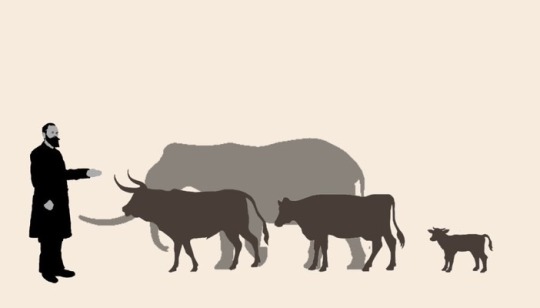
(Bos primigenius thrinacius n. ssp. Size estimate of a bull, cow, and calf compared to a human and an adult Palaeoloxodon falconeri. Art by Joschua Knüppe)
This new sub species of Aurochs lived on the Greek island of Kythera during the Late Pleistocene. The sub species was probably present on Kythera while it was still part of the mainland, but became trapped when it was separated sometime during the Middle to Late Pleistocene and their small size was a result of insular dwarfism. Insular dwarfism is a common phenomenon in evolution where a population of large animals becomes trapped on an island and slowly evolve to become smaller over time to better adapt to the reduced space and resources. The opposite, insular gigantism, where an island-bound population of small animals grows larger than their mainland counterparts also occurs regularly. During the Pleistocene, the various islands of Greece were full of giant swans and miniature elephants but now we know they had tiny cattle roaming about as well.
2. Garumbatitan morellensis
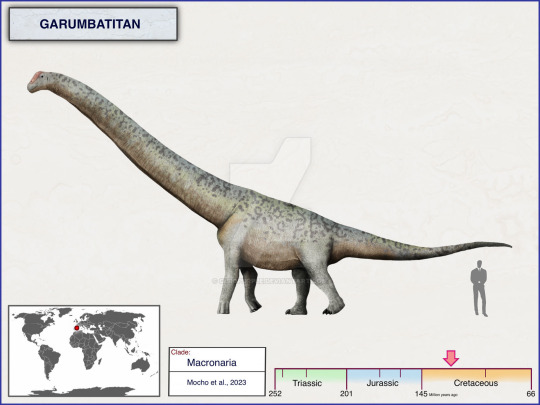
(Size comparison between Garumbatitan morellensis and a human. Art by cisiopurple on Deviantart)
Meaning “Garumba Giant”, Garumbatitan morellensis was a species of sauropod dinosaur that lived during the Cretaceous period in what is now Spain. Its remains were first discovered in 1998 at the Arcillas de Morella Formation near the city of Morella, however, they would not be excavated until an expedition in 2005. More material would later be discovered in a 2008 expedition and a paper would be published on the findings in 2016, but it wasn’t until this year that the species was officially named and described. Its genus named is a mix of the name for the tallest mountain in the region it was discovered in, Mola de la Garumba, and the Greek word “Titan”.
3. Nihohae matakoi
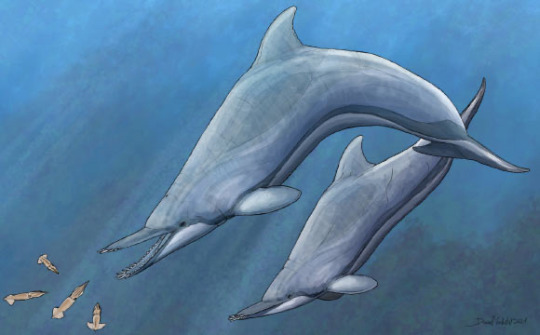
(A pair of Nihohae matakoi hunting some squid. Art by Daniel Verhelst)
Nihohae matakoi was a species of dolphin that belonged to the now extinct Waipatiid family and lived during the Oligocene in the waters surrounding what is now New Zealand. It possessed a bizarre set of tusk-like teeth that protruded from its beak. It is thought that this dolphin used it’s strange teeth much like a sawfish to stun their prey before consuming them. The holotype specimen was discovered all the way back in 1998 in Awamoko Valley on New Zealand’s South Island. The specimen consisted of a nearly complete skull, a single atlas and axis, eight vertebrae, and seven ribs. However, Nihohae matakoi would not be officially described until 2023. Its genus name combines the Māori words “Niho”, meaning “teeth”, and “Hae”, meaning “slashing”. The species name is also derived from Māori and comes from the words “Mata”, meaning “face” or “point”, and “Koi”, meaning “sharp”.
4. Perucetus colossus
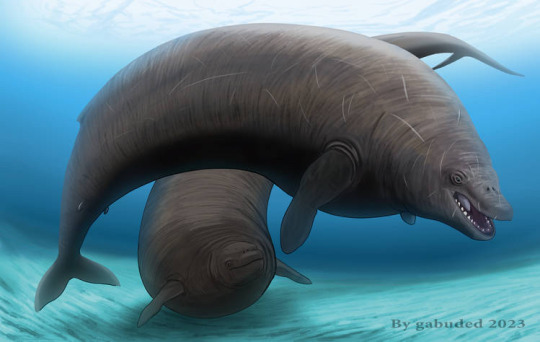
(A pair of Perucetus swim together in the shallows. Art by Gabuded on Deviantart)
Another cetacean, Perucetus colossus was a species of early whale that lived during the Bartonian age of the Middle Eocene and was found in Peru (obviously). The remains we have or Perucetus are pretty fragmentary, but it has an estimated length of around 55.8-65.9 ft and was probably just as, if not heavier, than the modern Blue Whale. Due to the density of its bones and its absolute chonkiness, Perucetus likely was not a fast swimmer and likely lived in shallow waters and fed on crustaceans and mollusks. However, this is just speculation as very little about its ecology is known.
5. Vectipelta barretti

(A pair of Vectipelta barretti graze near a stream. Art by Stuart Pond)
Vectipelta barretti was an ankylosaurian dinosaur that lived during the Early Cretaceous in what is now England. It was discovered in the Wessex Formation and it’s genus name means “Isle of Wight shield”. The holotype specimen of Vectipelta was originally discovered in November of 1993, however, at the time it was believed that the specimen belonged to the genus Polacanthus. In May of 2021 it was discovered that the specimen was in fact a new genus and in June of 2023 it was officially named and described. Funnily enough, fossil evidence suggests that Vectipelta might be millions of years older than Polacanthus, the genus it was originally thought to be a member of.
I hope you all enjoyed reading about these recently described prehistoric species! I LOVE dinosaurs and other extinct animals and can’t wait to see what new discoveries 2024 has to offer!
#dinosaur love#animals#new discoveries#infodump#science#dinosaur#peru#new zealand#isle of wight#Kythera#new species#animal news#animal facts#dinosaur facts#paleontology#spain#2023#ankylosauria#sauropod#aurochs#cetacean#perucetus
24 notes
·
View notes
Text
TIL that the man who proposed the theory of insular dwarfism, Baron Franz Nopcsa von Felső-Szilvás, was also the first person ever to hijack a plane.
15 notes
·
View notes
Note
Honestly I agree with UNH that the world of monster hunter went through an ice age considering some of the monsters we see either in the new world or on the various islands don't really have a way to transverse across water. Heck when I was watching one of Tea Sharks video about monster hunter trivia and tidbits, showing Deviljhos old tri model and his world model and Tri model is smaller than world model so some possible insular dwarfism.
Yeah ice age seems likely considering the old and new world monster species and the fact that some apex predators are implied to have had predators, or were designed with adaptations that make more sense if there were once bigger monsters to fear.
Akantor’s spikes are canonically anti-predator defenses.
And there’s even remnants of monsters that don’t exist anymore like the giant tyrannosaur skull in the Jurassic frontier.
However monsters could potentially also travel between places using tunnels and cave systems subterranean monsters like shara, Giasmagorm, and Kulve dug out.
11 notes
·
View notes
Text
Round 1, part 2, match 16: our close relatives
†Flores hobbit (Homo floresiensis)

Artwork credit: Julio Lacerda
This hominin species was endemic to the Indonesian island of Flores from 100,000 to 60,000 years ago. Because of a phenomenon known as insular dwarfism, where island animals grow smaller due to less available food, H. floresiensis grew to a height of only 3 ft 6 in (1.06m) tall, giving it the species nickname of hobbit. They likely had a similar generalist diet to us, and are known to have crafted stone tools to help them hunt. They lived alongside other prehistoric inhabitants of Flores, including cattle-sized relatives of elephants, rabbit-sized rats, human-sized storks, and Komodo dragon lizards.
†Neanderthal (Homo neanderthalensis)

Artwork credit: Tom Björklund
Our closest relatives, the Neanderthals, lived in Eurasia up until about 40,000 years ago. They were shorter and bulkier than us, with larger skulls, and genetic testing reveals they had a variety of skin colours but generally had lighter brown or red hair. They were prolific hunters of megafauna, but probably foraged for other food sources as well. They used stone tools, cooked their food, probably made clothing, and some seem to have used boats to reach Mediterranean islands. The fact that Neanderthals are often found with healed injuries reveals that they had a good knowledge of medicinal herbs and how to treat injuries, and that they cared for the sick and injured members of their society. Their extinction coincides with the arrival of our species into Europe, and many prehistoric relationships between humans and Neanderthals have led to the presence of Neanderthal DNA in most modern humans.
19 notes
·
View notes
Text
Me automatically rejecting canon and giving all the rescuebots unique Cybertronian root modes and altmodes because i can and because that Blades having wheels comment. This also goes with when i think they were frozen in the war (closer to the middle, while Bumblebee was created juuust as Cybertron died) and I'm just gonna slip in the headcanon that their colors were different when they were on Cybertron, because transformers and humans are differently wired and our heads have different "Pay Attention Motherfuckers" colors
I headcanon that Blades's altmode, as mentioned above, was ground based. I see him as being sort of a combination of a racer and an emergency vehicle, considering his training and his earth altmode. He's the EMT of the group.
I think Boulder's altmode was closer to a midsized all terrain vehicle, a lot less strictly construction based as his earth alt is. From what I can see, he's the engineer of the group. He evaluates infrastructure and helps fix what needs fixed— whether it's damage or faulty designs.
In my head I keep returning to the idea that Heatwave's altmode and root was bigger on Cybertron than it is on earth, but i think that's in general the fact that wow is he the firetruck equivalent of insular dwarfism. He's definitely got experience with dealing with fire, but in my head i think his original job also dealt with hazardous chemical leaks and collapses.
Chase is a difficult mark because based on his vibes i think his altmode was pretty similar— just the most average civilian vehicle mod possible. But also because in the tfwiki it says these guys are essentially search and rescue, and considering how the topic of rescuebots is treated it seems like the rest of them were gone-inated either pretty early in the war or were themselves a prototype project. I honestly do not see where the cop angle fits into the environment we've been given.
But hey! I accept being wrong on exactly every angle! And the altmode headcanons are very likely probably not canon, especially since how Cybertron is depicted in rescuebots is pretty damn different than it is in the rest of aligned (honestly it's pretty different than how it's depicted in RBA, but that can be chalked up to the idea of things being different ever since Cybertron was reborn)
#transformers#transformers rescue bots#is it just me or does the life on Cybertron depicted in rescue bots seem... muted? more empty?#this is why i place them being frozen somewhere in the middle of the war#in some small area that while the war wasn't directly in their faceplates they knew it was going on in other places#to me there's an overwhelming sense of isolation in that show and to be honest it seems to reach into the backstories as well
33 notes
·
View notes
Text
Snake Swag Bracket Round 1

Here we have a pair of pythons! Ball pythons (Python regius) are also known as royal pythons, and they are hugely popular in the reptile pet trade! Their native habitat is Sub Saharan Africa, from the west in Senegal and Cote D'Ivoire and eastward into Chad, Sudan, and Uganda, but in captivity they can be found all across the world. Reptile keepers love ball pythons for their generally calm, gentle, and inquisitive personalities. When threatened, as their name implies ball pythons will curl themselves up into a ball to try and keep themselves small and safe. One often heard complaint about ball pythons is that they can be picky eaters, sometimes going months at a time without accepting a meal. Dwarf Burmese pythons (Python bivittatus progschai) are a subspecies of Burmese pythons, and can be found on the Indonesian islands of Java, Bali, Sumbawa, and Sulawesi. Dwarf Burmese pythons are a great example of insular dwarfism! Insular dwarfism is when a species evolves to be smaller due to their range being limited to a small environment, and is particularly seen on islands. Dwarf Burmese pythons tend to grow up to around 8 feet in length (tiny compared to mainland Burmese python's length of up to 18 feet!), and while they are still rare in the reptile pet trade they are becoming more popular. Unfortunately, some breeders will sell mainland Burmese pythons as Dwarf Burmese pythons, often leading to the pythons being rehomed or abandoned in the wild when they become much larger than their keeper was expecting.
22 notes
·
View notes